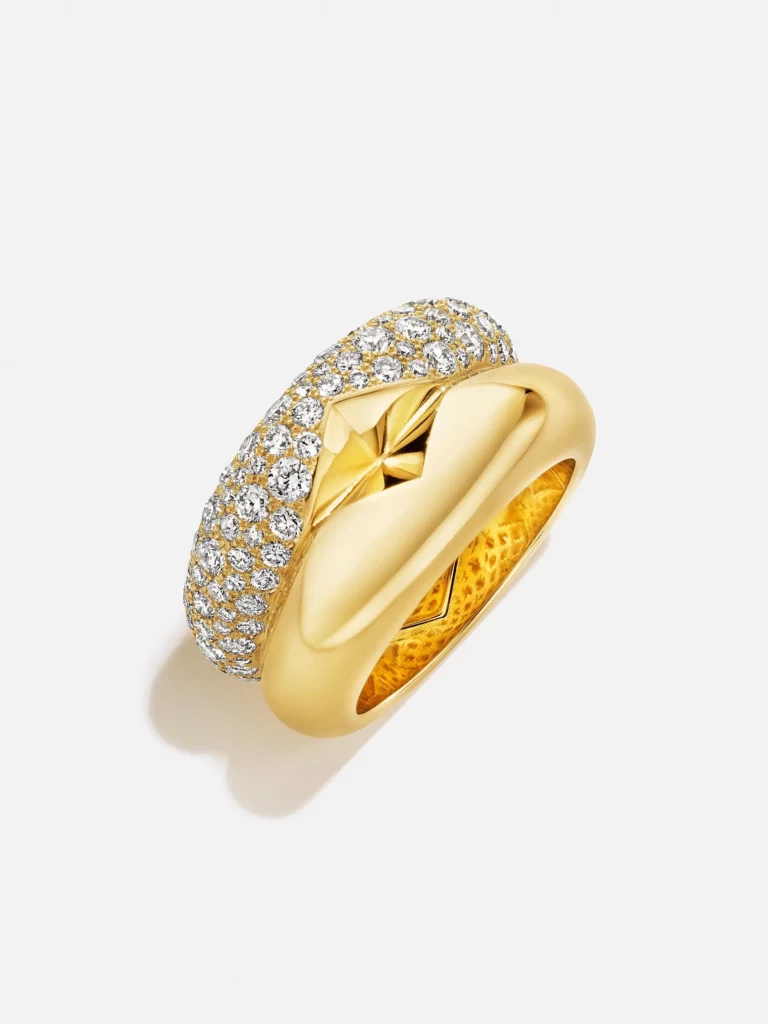Aether Diamonds has released the Bombé Collection, its first fine jewelry line made with its lab-grown diamonds, inspired by New York City’s endurance over the last century.
On its continued quest to prove that luxury and sustainability are one and the same, Aether Diamonds says its new Bombé Collection symbolizes “the release from an uncertain future as a joyous awakening.”
“We’ve been waiting to show the world what’s possible with our diamonds, and we are thrilled to introduce our Bombé Collection,” Ryan Shearman, Co-Founder and CEO at Aether, said in a statement. “It’s a collection that proves that luxury and sustainability can come together seamlessly with great design, diamonds from air, and Fairmined Gold; a unique combination that signals where jewelry is heading.”
Jewelry is indeed heading in a new direction, one largely paved by Aether since it first launched in 2020. The company became the world’s first to produce lab-grown diamonds from atmospheric carbon and has since been disrupting the jewelry industry by making sustainable, ethical diamonds more widely available.

While leading luxury jewelry brands including Cartier, Tiffany & Co., Chopard, and Bulgari, have been slow to embrace lab-grown diamonds, that may soon be changing. In June, LVMH, which owns Tiffany & Co., invested in Israel-based lab-grown diamond producer Lusix. Revived legacy jewelry brand Oscar Massin is also focused on lab-grown diamonds and recycled gold.
And despite noteworthy efforts to transform the mined diamond industry, younger consumers are seeking out lab-grown options not just for their transparency, but their affordability, too. On average, lab-grown diamonds are priced 50 to 70 percent less than mined diamonds.
The Bombé Collection
The new collection designed by Jenna Housby, Chief Design Officer at Aether Diamonds, takes its inspiration from New York City—specifically its “enduring ability for social and economic revival.” Housby cites the Roaring Twenties through to the Studio 54 era.
“[T]his collection embodies the narrative of alleviating future uncertainty, overcoming adversity with bold self-expression, and a desire to create something better,” Aether said. “Not only was Studio 54 a celebration of life, but also ambitious in its vision to move culture forward as one of the first non-judgmental, queer-friendly, mainstream nightclubs.”
The Bombé Collection is highlighted in a new campaign photographed and directed by Jake Rosenberg that features young climate activists including choreographer, producer, and soloist at the American Ballet Theatre, Gabe Stone Shayer; sustainable fashion advocate, photojournalist, and labor rights activist, Aditi Mayer; and environmental scientist Nikita Elyse.
Aether Diamonds are made from atmospheric carbon—a technique that uses carbon sequestration technology to pull CO2 directly from the air and transform it into diamonds.
Carbon capture technology is also being used to create materials—Zara has released dresses made from carbon-captured yarn. It’s also used in alcohol both as a base for perfumes and spirits. It’s also being explored as a means to create sustainable aviation fuel.
Climate impact
Aether says its use of captured carbon is unique in the lab-grown diamond world where most of the other lab diamonds are rooted in fossil fuels.
By using captured carbon, Aether says it creates a positive environmental impact; each carat of diamond it sells offsets a customer’s carbon footprint by more than a year, the company says. In comparison, the company says one carat of mined diamond typically removes 250 tons of earth, uses 127 gallons of water, releases 143 pounds of air pollution, and consumes countless gallons of fossil fuels while also contaminating major waterways with acid mine runoff.

In February, Aether Diamonds earned its B Corp certification, an achievement it says aligns with its core values. That’s resonating with investors, too. Its $18 million Series A funding round included backing from Ashton Kutcher, Guy Oseary’s Soundwaves, and the organization Helena.
“It’s really about the impact people want to have on the world and the future we all envision for ourselves,” the Aether team told Ethos in February. “The traditional diamond industry has been disastrous for the planet, and it’s had a huge impact on climate change and the communities and ecosystems surrounding mining sites,” the company said.
“By producing the world’s first diamonds from air, and the only truly sustainable diamonds in the market, our goal is to reverse the damage done to the planet and to stop the human rights and social issues that pervade the traditional diamond industry.”


